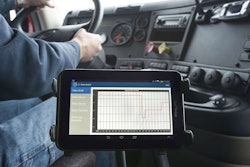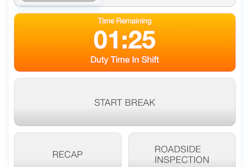 Erb International’s Wendell Erb, J.B. Hunt’s Greer Woodruff and Jetco Delivery’s Brian Fielkow discuss efforts to create sustainable safety cultures.
Erb International’s Wendell Erb, J.B. Hunt’s Greer Woodruff and Jetco Delivery’s Brian Fielkow discuss efforts to create sustainable safety cultures.Developing a safety culture in an organization involves more than a focus on compliance. In many cases it requires a complete restructuring of organizational responsibilities and finding new ways to change the attitudes of everyone in the company. In either case, any effort to establish a lasting company culture built around safety absolutely requires the buy-in of executive leadership, said Wendell Erb, president and CEO of Erb International, and Greer Woodruff, senior vice president of safety, security and driver personnel for J.B. Hunt.
The pair recounted their organizations’ efforts to develop safety cultures during the “Safety as a Core Value” panel discussion moderated by Jetco Delivery CEO Brian Fielkow at the Truckload Carriers Association’s 2018 Annual Meeting in Orlando.
Erb International’s culture shift started 30 years ago when the company’s safety rating dropped to conditional. “At that time, we would just truck as hard as we could and we thought that was normal,” said Erb.
That forced Erb International to reexamine its safety approach and put the carrier on the path to becoming one of the safest fleets in North America. It began by developing a training process to teach safety rules to drivers, dispatchers and front office personnel.
Erb International then held meetings with customers to relay the importance of their role in the company’s safety culture. “If the customer wants something different it needs to go on somebody else’s truck,” said Erb.
Today, Erb International’s safety culture starts before a driver is even hired. The company now uses a predictive index test to screen applicants, asking applicants to choose from a page of 60 words that best describe them. Based on the words chosen, the test helps the company identify an applicant’s character traits, including assertiveness, attention to detail and patience.
“It gives you an idea of what are you getting into with the person,” said Erb. “Once they are in the door, at that point it’s about making sure you can provide a company that meets their expectations.”
Erb says the company’s commitment 30 years ago to reshape its safety efforts has led to an organic culture that exists throughout the organization.
“Nowadays a driver won’t even consider doing something that shouldn’t be done because its engrained in the driver force,” said Erb.
Twenty years ago, J.B. Hunt’s primary focuses were growth and utilization. At the time, safety was viewed as a cost of doing business that sometimes was a barrier to its objectives.
Management saw the high cost of accidents and high driver turnover and recognized the number of indirect costs of an accident in addition to the direct costs.
After reassigning safety responsibilities and accountability within the organization and making business decisions through a safety lens, J.B. Hunt has transformed its company culture.
“Now our objectives are growth and utilization within the constraints of a safety culture and a commitment to taking care of our people and sharing the roads with the public,” said Woodruff. “Safety was viewed prior to that as a cost and a nuisance sometimes to getting the job done. Today safety is viewed as an investment.”
J.B. Hunt’s first move was to take safety responsibility from the human resources department and reassign it to its operations team. “Before we had really no accountability, and it was easy to blame each other,” said Woodruff. “Once we moved ownership over to operations they became accountable. That was a big difference that helped us get this culture adopted.”
J.B. Hunt also adopted the Smith System driver training program. The company started by training the entire leadership team before training operations staff and finally its drivers. “[The Smith System] became a common language that everyone could talk about. Everyone could communicate, and operations was more confident in their ability to converse about safety with a driver.”
Woodruff said a successful safety culture requires shared attitudes and belief of everybody in the organization, and executive leadership must provide resources to invest in safety. He said when carriers get started on integrating safety into the organization shouldn’t feel like they must make huge changes right away.
“There are a lot of little things that can be done early on that will evolve over time and when you look back at them and you see how mature things have become,” said Woodruff. “Get started with a safety culture and let things evolve.”












